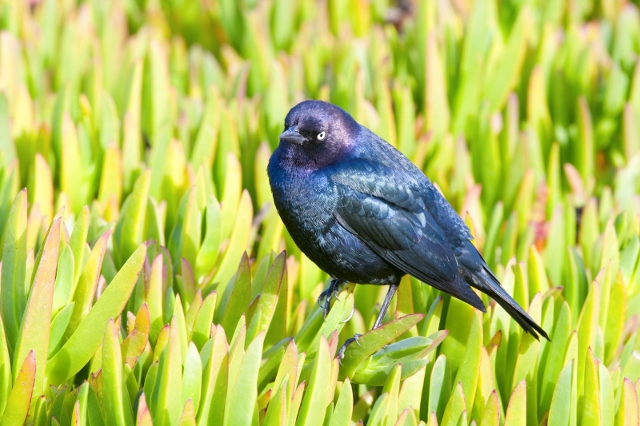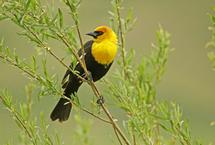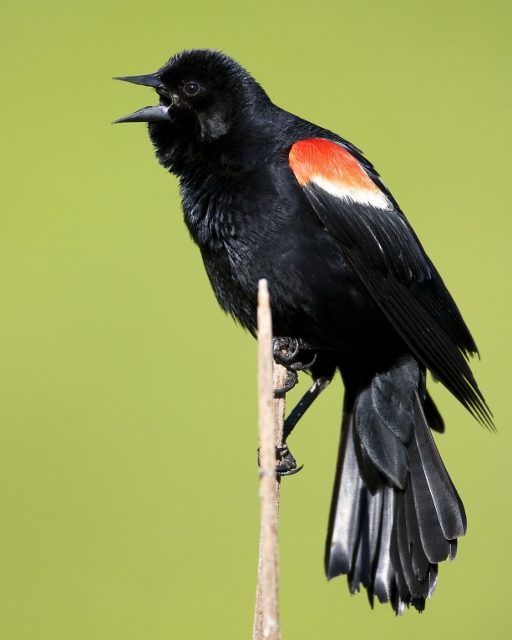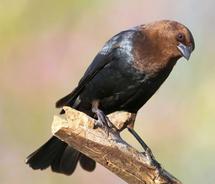saveourplanetearth.com
Call us: (775) 831-1331
Blackbirds: Brewer's, Yellow-Headed, Red-Winged and
Brown-Headed Cowbird
Sing a song of sixpence,
Pocket full of rye.
Four and twenty blackbirds,
Baked in a pie.
Or so goes the first verse of a nursery rhyme, dating back to the 1700s. It has popped into my head recently because I’ve been thinking about blackbirds, as I seem to have an abundance of Brewer’s blackbirds this fall at my feeders.
The male Brewer’s blackbird is glossy black, sporting an iridescent purple head with a staring yellow eye. The female is a drab dark gray with dark eyes.
They hop along the ground, foraging for food, bobbing their heads, much like chickens, scratching and pecking. Their flight is a rise and fall, and they will often circle before alighting on the ground.
His song is more of a cluck and a whistle. They eat seeds and insects, sometimes catching bugs in flight.
These birds are in the area year-round; in fact, last winter, a large number were poisoned in South Lake Tahoe in the Tahoe Keys. One bird was rehabilitated at Lake Tahoe Wildlife Care and released several days later. Killing of creatures can be avoided. One source for alternatives to the poisoning of pesky invaders is the website pesticide.org.
The Upper Truckee Marsh near the Tahoe Keys is a 600-acre marsh, where Trout Creek and the Upper Truckee River flow into Lake Tahoe, and the largest remaining wetland in the Sierra Nevada. It is managed by the California Tahoe Conservancy for the protection of habitat and breeding ground for the yellow-headed blackbird, among other species.
Breeding season at the marsh for the yellow-headed blackbird is May 1 through July 31 where they breed in colonies, the males mating with several females. During the breeding season, they eat insects and aquatic invertebrates in freshwater wetlands with dense vegetation.
In the winter, they will make their way south, forming large flocks, often mingling with other blackbirds, feeding on seeds and grains in open, agricultural areas.
It’s worth a trip in the spring to see this lovely blackbird, with his stunning yellow head and chest. The female is brown, with a duller yellow head.
In the last 150 years, development has eliminated more than half of the originally 1300-acre marsh. The Conservancy is working to restore and maintain what is left, which serves as a natural filtering system of water about to enter Lake Tahoe – recycling nutrients, trapping soil, and filtering pollutants, as well as providing habitat for wildlife and plant life, including a population of the endangered Tahoe yellow cress.
The next time you visit the marsh in the spring, keep watch also for the red-winged blackbird. The showy male, with the red and yellow patches on his wings, will be sitting on high perches, singing his easily identifiable conk-la-ree song, while the females prefer to stay hidden in the rushes, searching for food and weaving their nests.
One of my favorite places to camp in the summer is the Twin Lakes area, west of Bridgeport, California in part because there you will find a large congregation of red-winged blackbirds and I never tire of the cheerful song.
The first blackbird I see in the spring is the brown-headed cowbird. He’s a glossy black bird with a distinctive brown head. The females are smaller and all brown. They arrive at my feeders nearly always exactly on April 15, the only reason I look forward to Tax Day.
These birds don’t raise their own young; rather they lay their eggs in the nests of other birds, sometimes at the expense of the foster parent’s own young.
Occasionally I’ll have groups of cowbirds gathered in the trees near my feeders. The males take turns singing their bubbling songs and fluffing their wings, almost like they are shrugging their shoulders. It’s an incredible song which you can listen to, as well as a multitude of other bird song, on the website allaboutbirds.org, sponsored by the Cornell Lab of Ornithology.
They are the first blackbirds to arrive at my feeders in the spring, and they are the first to depart. I suppose by now they are basking in warm Mexico and I shall have to wait until April 15, when they return to charm me, and anyone else who cares to listen, with their bubbling song.
Brewer's Blackbird
canstockphoto.com
Red-Winged Blackbird
123rf.com
Yellow-Headed Blackbird
123rf.com
Brown-Headed Cowbird
123rf.com






